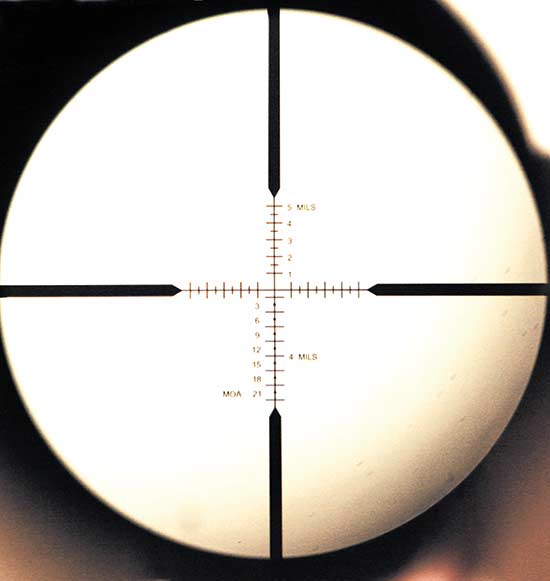Plane Talk on Reticles
1st Or 2nd Plane ... Does It Matter?
First focal-plane reticles have received lots of recent coverage, especially from longer-range shooters, even though most American shooters (in particular hunters) have a long-term preference for 2nd focal-plane reticles. To understand the differences we need to understand the telescopes, because riflescopes are basically telescopes using an in-line series of lenses to deliver a magnified image.
Most humans have used a magnifying glass to look at a small object, say a splinter in our thumb. If we decided to use two magnifying glasses at the same time to further enlarge our thumb, the image would appear upside-down.
This is due to the way lenses bend light, and also why riflescopes include at least one lens between the front and rear lenses. This 3rd, middle lens “erects” the image, so it appears right-side up, and is called the erector lens.
Most modern riflescopes contain more than three lenses, including at least two in the erector assembly. The erector assembly not only turns the image right-side-up, but is pushed by the elevation and windage turrets to adjust point of impact. In variable scopes the lenses in the erector tube also change the magnification via cams connected to the power ring on the outside of the scope, sliding the lenses closer together or farther apart.
Focal Plane Defined
The reticle can be placed either in front of the erector tube, toward the target, or behind the erector tube, toward our eye, the two positions where the lenses can focus on the reticle, making it appear sharp. Consequently these positions are named the focal planes, and reticles placed in the front focal-plane are often called FFP (for 1st or front), and those in the rear focal-plane RFP or SFP (for rear or 2nd focal-plane). We’ll use FFP and SFP. Each has its advantages and disadvantages.
Since FFP reticles are in front of the magnification-change lenses, they grow and shrink along with the image, remaining the same apparent size against the target. Since SFP reticles are behind the magnification mechanism, they aren’t magnified along with the target, so remain the same size within the scope, while the target image becomes larger or smaller.
Until recently, most shooters (especially hunters) preferred SFP reticles. We normally turn magnification up to aim at a more distant target, so prefer a “shrinking” reticle—though in reality the reticle stays the same size, while the target grows larger with more magnification. You can easily demonstrate this to yourself with any SFP variable you might have on hand.
But SFP reticles also magnify any slight shift in the alignment of the magnification-change lenses, possibly changing point of impact (POI). Until relatively recently this was a common problem, occurring as the lenses slid back and forth inside the erector tube. Some didn’t even return to the same POI when returning the magnification to the same place. A few years ago, legendary Marine sniper Chuck Mawhinney told me the issue 3-9X Redfield on his rifle never shot to the same place after the magnification was changed, the reason he always left it at 9X.
Since then, mass manufacturing has become so much more precise POI changes have practically disappeared, the reason the vast majority of shooters are happy with SFP scopes—but SFP reticles still change apparent size compared to the target. This became a problem after affordable, hand-held laser rangefinders appeared in the 1990s, allowing hunters to know the precise range, making longer-range hits possible.
The immediate solution was to add extra aiming points below the center of the reticle. This worked, but with SFP reticles the spacing of the marks varied with magnification. A hunter who set his Magic Reticle scope on 9X so the bottom hashmark was dead-on at 500 yards might turn the scope down to 4X when passing through woods, then forget to turn it up again when he saw a deer 500 yards away. At 4X the bottom hashmark was more than twice as far below the center of the reticle, and the result a low miss.
FFP Advantage
With the advent of multi-point reticles, some American hunters preferred FFP scopes because the dots or hashmarks in the scope always worked the same way, no matter the magnification. This remained true even after “dialing” the elevation turret for longer shots became common, because horizontal hashmarks provided a constant reference for wind-holds. Reticles also became thinner to allow more precise holds.
During this same period the magnification range started climbing, partly because shooters were attempting longer shots. While 3-9X scopes remain popular, many are switching to 3-18X. However, multi-point reticles in long-range are naturally designed for use at the highest magnification, and a shrinking FFP reticle that works well at 18X can almost disappear at 3X. In fact, they can even get pretty skinny at 3.5 in a 3.5-10X scope.
This doesn’t matter in certain target games, where the shooter might be required to shoot gongs at 10 yards and over 1,000 yards, but hunters (who tend to be older than average Americans) often find thin reticles difficult to see during twilight, when most game is active—one reason for the increasing popularity of illuminated reticles.
The easy solution to all of this is to leave your variable scope on the magnification where the reticle looks right and works correctly, exactly like Chuck Mawhinney in Vietnam. This is why fixed-power scopes are making something of a comeback among open-country hunters.
Even with fixed scopes, however, there’s so much talk about reticle placement these days that more than one prospective fixed-power customer has earnestly asked, “Is the reticle FFP or SFP?” The answer, of course, is it doesn’t matter.







